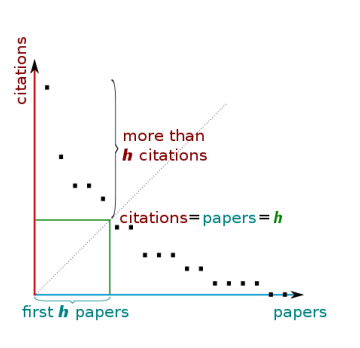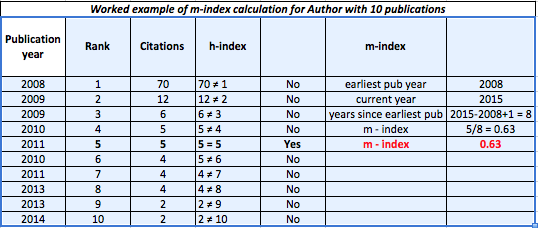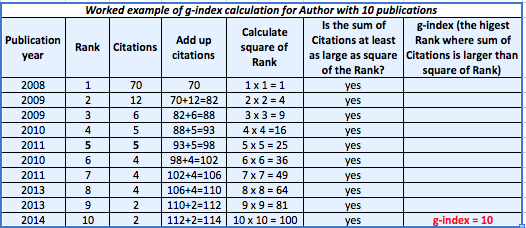Author-level metrics are citation metrics that measure the bibliometric impact of individual authors. H-index is the best known author-level metric, but there are also g-index, i10-index, author impact factor, and author-level Eigenfactor.
The h-index attempts to measure both the productivity and impact of the published work of a scientist or scholar. The calculation was suggested by an American physicist JE Hirsch and it can be summed up as:
A scientist has an index h if h of his/her Np papers has at least h citations each, and the other (Np h) papers have no more than h citations each.
In other words, to have an h-index of 5, an author has to have 5 publications, each receiving at least 5 citations.


The criticisms of the h-index include the fact that it does not account for highly cited papers (your h-index is the same whether you most highly cited paper has a 100 or 10 citations. Another criticism is that it does not account for the career span of the author – because it is a simple function of productivity and impact, authors with longer career spans (and more publications will always have higher scores).To help with these weaknesses h-index variants had been proposed.
There are a number of sources where you can find your h-index. Please note that the value of the index may vary depending on the source of information (number of indexed publications, time span, etc.) For instance, h-index derived from Google Scholar tend to be higher than that based on Web of Science or SCOPUS data.
Available via free software Publish or Perish, Scopus, or Google Scholar.
The g-index is a variant of the h-index that, in its calculation, gives credit for the most highly cited papers in a data set. In the words of Leo Egghe, its inventor:
“Highly cited papers are, of course, important for the determination of the value h of the h-index. But once a paper is selected to belong to the top h papers, this paper is not “used” any more in the determination of h, as a variable over time. Indeed, once a paper is selected to the top group, the h-index calculated in subsequent years is not at all influenced by this paper’s received citations further on: even if the paper doubles or triples its number of citations (or even more) the subsequent h-indexes are not influenced by this.”
The g-index is always the same as or higher than the h-index.

Available via free software Publish or Perish.
The i10-index is a metric created by Google Scholar and used in Google’s My Citations feature.
i10-Index = the number of publications with at least 10 citations.
Available via Google Scholar.
An individual impact factor is a measure of the average frequency with which your recent articles have been cited in a particular year.

For more information see: Pan, RK; Fortunato, S (2014). “Author Impact Factor: Tracking the dynamics of individual scientific impact”. Scientific Reports 4: 4880.
Author-level Eigenfactor is an attempt to use Eigenfactor methodology (originally developed to rank journals), to create a ranking list of authors in SSRN.
For description of the study and list of ranked authors see: West, JD; Jensen, MC; Dandrea, RJ; Gordon, GJ; Bergstrom, CT. (2013). “Author-level Eigenfactor metrics: Evaluating the influence of authors, institutions, and countries within the social science research network community“. Journal of the American Society for Information Science and Technology 64 (4): 787–801.
Metric Tracking Databases
- Google Scholar - Google Scholar provides a simple way to broadly search for scholarly literature. From one place, you can search across many disciplines and sources: articles, theses, books, abstracts and court opinions, from academic publishers, professional societies, online repositories, universities and other web sites. Connect Google Scholar and Clarkson University